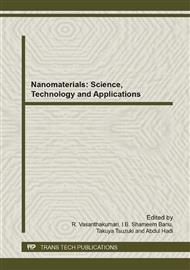[1]
M.T. Olaleye, B.T.J. Roch, Acetaminophen-induced liver damage in mice: effects of some medicinal plants on the oxidative defense system, Exp. Toxicol. Pathol. 59 (2008) 319–327.
DOI: 10.1016/j.etp.2007.10.003
Google Scholar
[2]
M. Mazer, J. Perrone, Acetaminophen-induced nephrotoxicity: pathophysiology, clinical manifestations, and management, J. Med. Toxicol. 4 (2008) 2–6.
DOI: 10.1007/bf03160941
Google Scholar
[3]
J. E. James, Caffeine and Health, Academic Press Inc, San Diego, (1991).
Google Scholar
[4]
C. J. Reissig, E. C. Strain, R. R. Griffiths, Caffeinated energy drinks—A growing problem, Drug Alcohol Depen. 99 (2009) 1–10.
DOI: 10.1016/j.drugalcdep.2008.08.001
Google Scholar
[5]
L. A. Pini, S. Guerzoni, M. Cainazzo, M. Ciccarese, M. P. Prudenzano, P. Livrea, Comparison of tolerability and efficacy of a combination of paracetamol + caffeine and sumatriptan in the treatment of migraine attack: a randomized, double-blind, double-dummy, cross-over study, J Headache Pain 13 (2012).
DOI: 10.1007/s10194-012-0484-z
Google Scholar
[6]
D. Emre, N. Ozaltun, Simultaneous determination of paracetamol, caffeine and propyphenazone in ternary mixtures by micellar electrokinetic capillary chromatography, J. Chromatogr. B 847 (2007) 126-132.
DOI: 10.1016/j.jchromb.2006.09.036
Google Scholar
[7]
J. T. Franeta, D. Agbaba, S. Eric, S. Pavkov, M. Aleksic, S. Vladmirov, HPLC assay of acetylsalicylic acid, paracetamol, caffeine and phenobarbital in tablets, II Farmaco 57 (2002) 709-713.
DOI: 10.1016/s0014-827x(02)01265-x
Google Scholar
[8]
M. A. Oliva, R. A. Olsina, A. N. Masi, Selective spectrofluorimetric method for paracetamol determination through coumarinic compound formation, Talanta 66 (2005) 229-235.
DOI: 10.1016/j.talanta.2004.11.015
Google Scholar
[9]
S. I. Ohkoshi, S. Yorozu, O. Sato, T. Iyoda, A. Fujishima, K. Hashimoto, Photoinduced magnetic pole inversion in a ferro-ferrimagnet: (FeII0. 40MnII0. 60)1. 5CrIII(CN)6 , Appl. Phys. Lett, 70 (1997) 1040–1042.
DOI: 10.1063/1.118475
Google Scholar
[10]
M. Jayalakshmi, F. Scholz, Performance characteristics of zinc hexacyanoferrate/prussian blue and copper hexacyanocferrate/Prussian blue solid state secondary cells, J. Power Sources 91 (2000) 217–223.
DOI: 10.1016/s0378-7753(00)00475-4
Google Scholar
[11]
A. A. Karyakin, Prussian blue and its analogues: electrochemistry and analytical applications, Electroanalysis 13 (2001) 813–819.
DOI: 10.1002/1521-4109(200106)13:10<813::aid-elan813>3.0.co;2-z
Google Scholar
[12]
Y. Bo, W. Wang, J. Qi, S. Huang, A DNA biosensor based on graphene paste electrode modified with Prussian blue and chitosan , Analyst 136 (2011) 1946–(1951).
DOI: 10.1039/c1an15084g
Google Scholar
[13]
A. S. Adekunle, K. I. Ozoemena, Electrocatalytic oxidation of diethylaminoethanethiol and hydrazine at single- walled carbon nanotubes modified with Prussian blue nanoparticles, Electroanalysis 22 (2010) 2519–2528.
DOI: 10.1002/elan.201000289
Google Scholar
[14]
D. Ivekovic, A. Gajovic, M. Ceh, B. Pihlar, Prussian Blue-Modified Titanate Nanotubes: A Novel Nanostructured Catalyst for Electrochemical Reduction of Hydrogen Peroxide, Electroanalysis 22 (2010) 2202 – 2210.
DOI: 10.1002/elan.200900622
Google Scholar
[15]
S. J. Sophia , S. Devi, K. Pandian, Amperometric Detection of Nitrite Using Chitosan Protected Nickel Hexacyanoferrate Nanoparticles Modified Glassy Carbon Electrode, Asian J. Chem. 25 (2013) S366-S368.
DOI: 10.1166/adel.2013.1010
Google Scholar
[16]
D. V. Bavykin, J. M. Friedrich, F. C. Walsh, Protonated Titanates and TiO2 Nanostructured Materials: Synthesis, Properties, and Applications, Adv. Mater. 18 (2006) 2807-2824.
DOI: 10.1002/adma.200502696
Google Scholar
[17]
Q. Gao, X.Q. Cui, F. Yang, Y. Ma, X. R. Yang, Preparation of poly(thionine) modified screen-printed carbon electrode and its application to determine NADH in flow injection analysis system, Biosens. Bioelectron. 19 (2003) 277- 282.
DOI: 10.1016/s0956-5663(03)00212-4
Google Scholar
[18]
J. Jkac, J. W. Whittaker, T. Ruzgas, The use of single walled carbon nanotubes dispersed in a chitosan matrix for preparation of a galactose biosensor, Biosens. Bioelectron. 22 (2007) 1820-1824.
DOI: 10.1016/j.bios.2006.08.014
Google Scholar
[19]
T. Kasuga, M. Hiramatsu, A. Hoson, T. Sekino, K. Niihara, Formation of titanium oxide nanotube, Langmuir, 14 (1998) 3160–3163.
DOI: 10.1021/la9713816
Google Scholar
[20]
A. A. A. Hajjaj, B. Zamora, D. V. Bavykin, A. A. Shah, F. C. Walsh, E. Reguera, Sorption of hydrogen onto titanate nanotubes decorated with a nanostructured Cd3[Fe(CN)6]2 Prussian Blue analogue, Int. J. Hydrogen Energy, 37 (2012) 318–326.
DOI: 10.1016/j.ijhydene.2011.09.094
Google Scholar
[21]
S. J. Sophia, S. Devi, K. Pandian, Hexacyanoferrate-Decorated Titania Nanotube: CoHCF@TNT Modified GCE as an Electron Transfer Mediator for the Determination of Hydrazine in Water Samples, ISRN Analytical Chemistry, 2012 (2012) 8 pages.
DOI: 10.5402/2012/192698
Google Scholar
[22]
B. C. Lourencão, R. A. Medeiros, R. C. Rocha-Filho, L. H. Mazo, O. Fatibello-Filho, Simultaneous voltammetric determination of paracetamol and caffeine in pharmaceutical formulations using a boron-doped diamond electrode, Talanta 78 (2009).
DOI: 10.1016/j.talanta.2008.12.040
Google Scholar
[23]
A. P. P. Eisele, D. N. Clausen, C. R. T. Tarley, L. H. D. Antonia, E. R. Sartori, Simultaneous Square-Wave Voltammetric Determination of Paracetamol, Caffeine and Orphenadrine in Pharmaceutical Formulations Using a Cathodically Pretreated Boron-Doped Diamond Electrode, Electroanalysis 25 (2013).
DOI: 10.1002/elan.201300137
Google Scholar
[24]
J. M. Zen, Y. S. Ting, Simultaneous determination of caffeine and acetaminophen in drug formulations by square-wave voltammetry using a chemically modified electrode, Anal. Chim. Acta 342 (1997) 175-180.
DOI: 10.1016/s0003-2670(96)00527-2
Google Scholar


